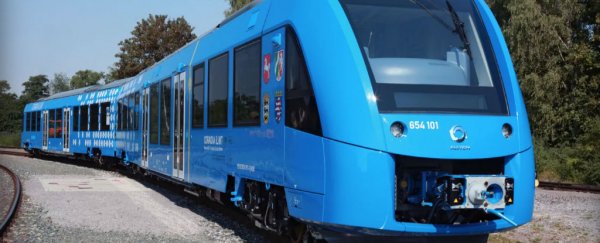The world's first hydrogen-powered passenger train has been unveiled this week by French transport company Alstom, which will be operating the incredibly quiet and environmentally friendly 'Coradia iLint' in Germany from next year.
The best thing about the Coradia iLint train is that it only leaks excess steam and condensed water into the atmosphere, which means it offers a zero-emissions alternative to Germany's 4,000-strong fleet of diesel trains.
The train was presented to the public for the first time last week at Berlin's InnoTrans trade show. Nicknamed the hydrail, it's set to become the first hydrogen-powered passenger train to regularly operate over long distances.
The iLint is expected to run on the Buxtehude-Bremervörde-Bremerhaven-Cuxhaven regional line in the northwestern German state of Lower Saxony, with testing and approval procedures to be carried out later this year, and public access to open up by December 2017.
According to German newspaper Die Welt, Lower Saxony's local transportation authority has so far ordered 14 iLint trains from Alstom, and if they prove to be a success, more will likely be seen in other regional areas of the country.
Interest in the train has also been expressed by leaders in the Netherlands, Denmark and Norway.
The iLint is powered by massive lithium ion batteries, which get their energy from a hydrogen fuel tank installed on the roof. On a full tank, which requires about 94 kg per car, the hydrail can operate for an entire full day, or travel up to 800 km. Its top speed is reportedly 140 km/h (87 mph).
Hydrogen-powered technology for trains has been around for just over a decade now, but rather than being used to ferry us humans around, full-hydrogen and hybrid versions have so far only been used in the freight industry.
As Christina Beck from The Christian Science Monitor reports, back in 2004, the Japanese Railway Research Institute developed a prototype fuel cell, and it went into use two years later. And last year, China started using hydrogen to power its trams in an effort to curb its severe air pollution problem.
The difference here is that Germany's Coradia iLint will be able to transport 300 passengers at a time, and will be the first fully hydrogen-powered train to complete run long-distance routes
While carbon-based emissions from trains are actually a whole lot better than emissions from other types of vehicles - only 2.6 percent of Australia's transport greenhouse gas emissions are attributable to rail, including passenger and freight - Germany's commitment to renewables is stretching to just about any industry that it can feasibly apply.
And it's paying off: on 8 May 2016, an impressive 95 percent of Germany's power demands were met by renewable energy sources, and at certain points during the day, certain members of the public were being reimbursed for their energy usage.
"Power prices actually went negative for several hours, meaning commercial customers were being paid to consume electricity," Michael J. Coren reported for Quartz at the time.
Not bad for one of the most developed and industrialised nations in the world.
Germany now plans on achieving an overall 60 percent share of renewable energy sources by 2050, which means it still has a whole lot of room to grow before it can catch up to Costa Rica, which earlier this month announced that it has been running on 100 percent renewable energy for two months straight.
Let's hope the iLint can eventually replace the country's 4,000 diesel trains, and get them closer to their goal.
Here's a quick run-down of how the technology works (larger version here):
Alstom Coradia-iLint Decryption en OK by ahawkins8223 on Scribd
